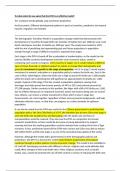To what extent do you agree that the DTM is an effective model?
Yes- Compare trends globally, past and future projections
No-Eurocentric, Different development patterns in parts of countries, pandemics and natural
hazards, migration not included
The Demographic Transition Model is a population change model that demonstrates the
development of countries through birth rate (number of babies born per 1000 per year,) and
death rate figures (number of deaths per 1000 per year.) The model was created in 1929,
with the aim of predicting and representing past and future projections in population
change through a range of different countries, separated into stages.
Each stage in the DTM is based off the acceleration of modernisation, so the model can be
used to identify countries development and their socio-economic status, aswell as
comparing each country’s progress. Every country in stages 1 to 5, would require a different
type of social, financial, or political support to sustain or change their demographic and
generally investment is specific to the stage of progression. An LIC in stage 2 would require
investment in women’s education or a population policy to reduce the birth rate. Such is the
case of Mali, Sahel Region, where the birth rate is high at around 44 births per 1,000 people,
while the death rate is declining but still significant at approximately 10 deaths per 1,000
people, (typical of this stage.) This has created a population explosion causing food
shortages and wide-spread low income poverty of 44% in 2021 and extreme poverty for
375,000 people. Similar countries in this position, like Niger with a BR of 45 births per 1,000,
due to children being such an important economic assets and women being seen as second
class citizens, can receive a similar investment to Mali, which is also in stage two.
Governments can come together, regardless of their socio-economic backgrounds, and help
eliminate collective issues, so that they can progress as a collect towards an optimum
population.
It can also be noted that the DTM was useful for the Chinese government in justifying their
population policy- the One Child Policy of 1979, the intention was to force China into stage 4,
were the birth rate would be low and fluctuating with the death rate and fears of
overpopulation would be reduced. They also saw the DTM as a projection to increase
economic productivity, as there would be less issue of young dependants to support,
meaning tax from the working population could be invested into creating China into a Tiger
economy. In fact, predictions based off the DTM were correct and China was able to reduce
400 million birth’s and fly into stage 4, as one of the manufacturing capitals of the world.
However, although the model aide's governments in their demographic policies and
projections, the DTM is a Eurocentric model based historic progressions of European
countries through a similar pattern of socio-economic change. This model is less relatable to
LIC and MIC developing countries with different cultures, religions and social attitudes that
could affect changes in birth and death rates. Many religious countries such as Saudia
Arabia, Asia, would not promote the use of birth control as means of reducing the birth rate.




